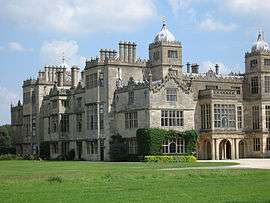Catherine Howard, Countess of Suffolk
Catherine (or Katherine) Howard, Countess of Suffolk (1564–1638), was an English court office holder. She served as lady-in-waiting to the queen consort of England, Anne of Denmark. She was born in Charlton Park, Wiltshire, the oldest child of Sir Henry Knyvet and his wife Elizabeth Stumpe.[1] Her uncle was Sir Thomas Knyvet, who foiled the gunpowder plot.

Private life
Early in her life, she married Richard Rich, son of Robert Rich, 2nd Baron Rich, and grandson of Richard Rich, 1st Baron Rich. After his death in 1580 she then married Sir Thomas Howard, who twenty years later was named the Earl of Suffolk.
On the death of her father in 1598 she inherited Charlton Park, Wiltshire, which thereafter became the seat of the Earls of Suffolk.
Courtier
Howard gained a place in Queen Elizabeth's bedchamber and the title of Keeper of the Jewels in 1599. This honour went further as she was also granted authority over the lodgings where Queen Anne gave birth to the princess. In fact, she was in such a position of high esteem within the court, she would have been given the honour of godmother to Princess Sophia born of Queen Anne if the child had not perished. She danced in two of the queen's masques, one of which was written by Ben Jonson, titled The Masque of Blackness. King James wanted the actors to look African so the actors painted their faces black. In 1611, the poet Emilia Lanier chose to dedicate her poem Salve Deus Rex Judaeorum to her.[2]
Howard strived with some success to gain rank in court but proved to be corrupt. She served as a liaison between Spain and Salisbury, and demanded bribes for doing so. Sir Thomas Howard was appointed Lord Treasurer, which allowed her more opportunity for financial gain. Howard was known to be very beautiful in her younger years, and during her time at court had many suitors and a string of alleged love affairs, using the position her husband achieved in the government to extort kickbacks from her lovers. However, in 1619, at the age of 55, she was the victim of an attack of smallpox "which spoiled that good face of hers, which had brought to other much misery and to herself greatness which ended with much unhappiness." Many of the details of her corruption came out in the Suffolk's trial in the same year, where Sir John Finet alleged "to be spared a bond of £500, a citizen gave £83 and a sable muff to the countess".
The Countess was ultimately caught and, as a result of her treachery, she and her family were banned from court. Peers generally sympathised with Sir Thomas for being caught in her web of corruption, and she endured the brunt of the blame for the Howards' fall from grace. After being expelled from court, she continued to write letters on behalf of others seeking court positions.
Descendants

Howard had fourteen children:
- Theophilus Howard, 2nd Earl of Suffolk (1582–1640); married Elizabeth Hume
- Elizabeth Howard (c. 1583-1658); married firstly William Knollys, 1st Earl of Banbury, then Edward Vaux, 4th Baron Vaux of Harrowden
- Sir Robert Howard (1598–1653); married Catherine Nevill
- Gertrude Howard (born c. 1585)[3]
- Sir William Howard (1586–before 1672)
- Thomas Howard, 1st Earl of Berkshire (1587–1669); married Elizabeth Cecil. Inherited the Wiltshire estates (Charlton Park) that had passed on to his mother after her father's death.
- Catherine Howard (c. 1588–1673); married William Cecil, 2nd Earl of Salisbury
- Emily Howard (born 1589)[3]
- Frances Howard (1590–1632); married firstly Robert Devereux, 3rd Earl of Essex then Robert Carr, 1st Earl of Somerset
- Sir Charles Howard (1591–21 June 1626); married Mary Fitzjohn
- Henry Howard (1592–1616); married Elizabeth Bassett
- John Howard (1593–1595)[3]
- Edward Howard, 1st Baron Howard of Escrick (d. 24 April 1675)
- Margaret Howard (c. 1599 - 1608)
Notes
- Payne, Helen (2004). "Howard, Katherine, countess of Suffolk (b. in or after 1564, d. 1638)". Oxford Dictionary of National Biography. Oxford University Press. Retrieved 3 May 2016.
- Lanyer, Aemilia (1993). Susanne Woods (ed.). The Poems of Aemilia Lanyer: Salve Dues Rex Judaeorum. New York: Oxford University Press. Retrieved 11 October 2011.
- "Thomas Howard, 1st Earl of Suffolk". Tudor Place. Retrieved 30 December 2006.